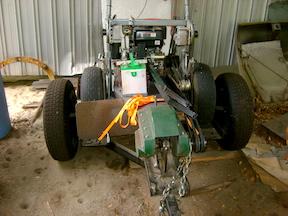
William Rawls can drive his stump grinder on and off its trailer and to the stump and back. While the 13-hp. Harbor Freight engine powers the grinding wheel, two small electric motors propel the grinder into place.
“I added the motors after using the grinder a few times,” says Rawls. “It tends to wallow down in the hole as it grinds, and it can be hard to get out.”
Moving it wasn’t easy either. The homemade stump grinder is heavy and awkward. Rawls built it around a frame his dad had used for oxyacetylene tanks.
“He built it heavy,” says Rawls. “I used a set of military wheels, narrowed the axle and welded it onto the frame.”
He added 3-in. channel iron for a frame and steel plate as a deck for the engine and grinding wheel. He mounted the engine behind the wheels to balance out the cutter wheel ahead of them. A centrifugal clutch on the motor drives a dual set of V belts to the drive axle of the grinding plate.
Rawls cut the 14-in. grinding wheel out of 3/8-in. steel and mounted carbide teeth on it. “I used horseshoe-style teeth,” says Rawls. “Next time, I will go with the round type that can be remounted when the leading side gets worn down.”
To make the stump grinder self-propelled, Rawls first mounted an alternator on the engine. It provides power to electric motors above each wheel and a 12-volt battery mounted on the deck. The battery powers the wheels if the engine isn’t running.
He connected the motors to large drive gears he welded to the wheels. “I got the motors at a military surplus chain,” explains Rawls. “They were designed to open and close tarps on big 10-wheelers. I put relays on them for reversing, and I turn it by running the motor on just the opposite wheel.”
He mounted sprockets on pivoting arms to either side of the drive chains. They’re connected by a spring.
“When one wheel is turning, the drive chain can get loose on the other,” says Rawls. “The springs maintain tension on them.”
Rawls has a ball mount hitch that he can attach to the stump grinder for towing. For more distant transit or road travel, he built a two-wheel trailer. It’s designed so he can drive the grinder up into place, chain it down and go.
“I built it from scratch using trailer wheels with bearings built into the hubs and stubs for mounting to an axle,” says Rawls.
He used 1 by 2-in. channel iron for the frame and 2 by 2-in. square tubing for the tongue. The axle is 2 by 3-in. steel tubing with risers at the end where the wheel stubs mount.
“I welded short lengths of 2 by 8-in. channel iron to the axles for the wheels of the stump grinder to sit,” says Rawls. “I welded a third piece of channel iron to the joint of the frame and the tongue as a rest for the cutter wheel.”
Rawls has used the stump grinder for about 3 years. “It works great and not just for stumps,” he says. When I get roots growing out of the ground or around a stump I’ve ground out, it slices right through them.”
Contact: FARM SHOW Followup, William Rawls, Currie, N.C. 28435.
